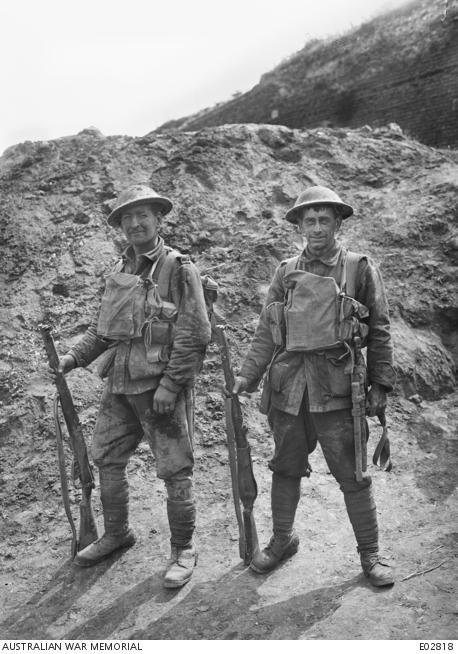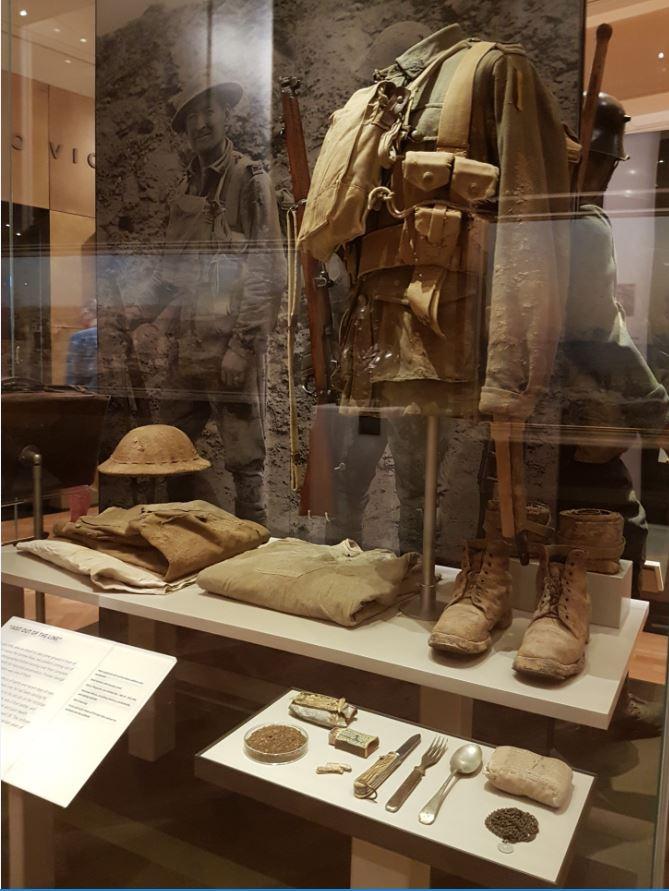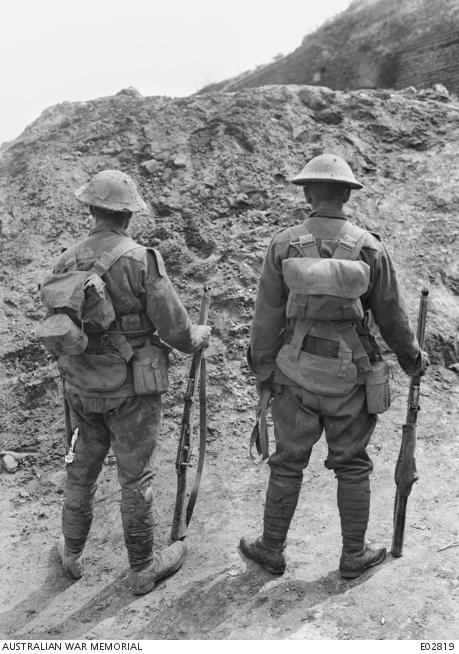A lasting legacy

Charles Bean's photograph of Private George James Giles, left, and Private John Wallace Anderton.
Private George Giles had just fought in the battle of Morlancourt and was marching back down into the valley of the river Ancre, when a tall, thin man in glasses approached and asked if he could have his uniform and kit.
It was July 1918 and the man was war correspondent and official historian Charles Bean. He wanted Giles’s torn and battered uniform to show what life on the Western Front was really like for ordinary soldiers.
Giles agreed, and Bean took reference photographs on the spot before organising for Giles’s outfit to be replaced.
More than 100 years later, Giles’s mud-encrusted uniform, along with his helmet, ammunition pouches, and kit, is one of the Australian War Memorial’s most treasured collection items.
It has come to symbolise the Australian digger to generations of visitors and features in a new highlights audio tour at the Memorial.
Visitor services manager Gerard Pratt said the new highlights audio tour tells the personal stories behind a range of collection items from the First World War through to Afghanistan.
“Giles’s mud-smeared uniform embodies all the attributes that the Memorial is known for – collecting original objects with their personal stories from ordinary servicemen and women, and preserving these objects as they were found,” he said.
“The new highlights audio is another way in which the Memorial is helping Australians to remember, interpret and understand Australia’s experience of war and its enduring impact on society.”

Giles’s own story is reflective of so many during the First World War.
He was a 33-year-old labourer when he enlisted in the Australian Imperial Force in May 1916 and embarked for overseas service with reinforcements to the 29th Battalion aboard the troopship Port Melbourne.
He arrived in France in April 1917 and in July 1918 the 5th Australian Division successfully attacked the German positions at Morlancourt, taking two lines of trenches, 128 prisoners, and 36 machine-guns.
Although the weather conditions were fine, the trenches themselves were “in a very bad state with mud and water from the recent rain” and in some places men had to wade in water as high as their knees.
Giles was photographed as he came out of the line and his entire uniform, equipment, rifle and bayonet were collected, encrusted with mud.
Originally displayed on a figure entitled “Out of the Line” in the original Australian War Museum in Melbourne, Giles’s uniform and equipment have been displayed almost continuously at the Memorial in Canberra since it opened in 1941.
Giles’s uniform has been painstakingly preserved exactly as it was 100 years ago, and visitors to the Memorial can compare the distinctive pattern of mud with the photos taken by Bean after the battle.
Bean also collected Giles’s haversack that day, as well as his boots, and even the contents of his pockets, including his tobacco and saved butt-ends. He also recorded Giles’s quirky habits, such as the way he stored his eating utensils in his puttees, just below his knee.

Private Giles and Private Anderton. Giles has a knife, fork and spoon in his puttees.
But Giles’s war wasn’t over. Less than a month after the battle of Morlancourt, Giles was recommended for a Military Medal for his “conspicuous gallantry and devotion to duty” near Vauvillers, east of Villers-Bretonneux, on 9 August 1918.
During the August offensive, several of his comrades were wounded by snipers, who were operating from concealed positions at very close range.
“Giles though not a stretcher bearer, and in spite of the fact that he was exhausted, went forward and succeeded in dressing the wounds, of his comrades,” the recommendation reads.
“He organised stretcher parties and personally assisted to remove the wounded to a place of safety. By so doing, he undoubtedly saved the lives of several men. Throughout the whole operation he displayed great courage and coolness under most trying conditions. By his personal efforts he did much to ensure the success of his platoon.”
Giles served for the remainder of the war and was formally discharged on 14 September 1919. He died in June 1942, at the age of 58.
His grandson, Graeme Breman, and his wife Jenny, visited the Memorial in 2013 to view the uniform as it was being prepared for re-display in the new First World War galleries.
“I was four years old when my da passed away, but my memories of that wonderful man are as vivid today as they were the day he died,” Graeme later wrote on Twitter.
“I remain today so very proud of my wonderful grandfather. He will never be forgotten. God bless him.”
The highlights audio tour features a 60-minute tour of the First World War, Second World War and Hall of Valour galleries as well as an optional 30-minute tour of the Conflicts 1945 to Today gallery. It is available in multiple languages (English, Mandarin and Hindi) and also includes an Auslan mode for visitors who are hearing impaired. The tour costs $10 and is available from the Information Desk in the Orientation Gallery. No bookings are required.
For more information about visiting the Memorial, and the various tours available, visit here.